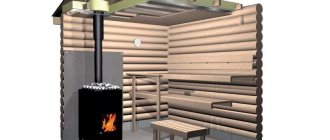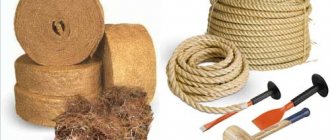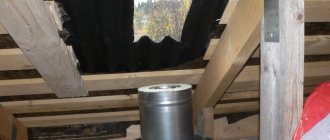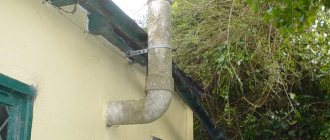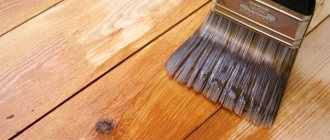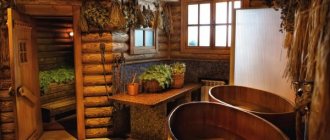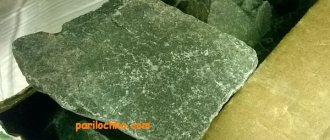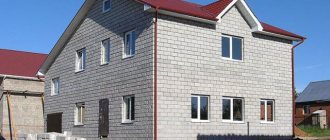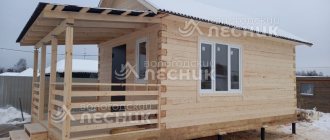When faced with the need to install a chimney for their own needs for the first time, a person may ask a reasonable question: which chimney is better?
Choosing the best chimney
To choose the best chimneys, you first need to decide which heating unit will be used. Since the best chimneys for a wood stove and fireplace are completely unsuitable for a gas boiler.
What to consider when choosing a material for a chimney?
A chimney is a complex structure consisting of a vertical pipe, an umbrella for protection from precipitation, an inspection window for maintenance, a tray for collecting condensate and other elements. The vertical pipe is considered the main part of the chimney, and the safety and efficiency of the stove or boiler depends on it.
To choose the right chimney material, you need to clearly understand what fuel will be used : natural gas, diesel fuel, coal, firewood, peat or sawdust. Each of them has a different combustion temperature, temperature and composition of the exhaust gases. Therefore, when selecting material for a chimney, the following parameters are taken into account :
- flue gas temperature. Naturally, the material must withstand slightly higher temperatures than those characteristic of the exhaust gases;
Approximate flue gas temperature (*high sulfur fuel) - corrosion resistance . When some types of fuel burn, vapors of sulfuric and hydrochloric acid are formed, which not every material can withstand. The more sulfur in the fuel, the more resistant to the effects of sulfur compounds the material must be. According to this parameter, chimneys are divided into three classes : the first - for removing gas combustion products, the second - firewood and liquid fuel with a sulfur content of up to 0.2%, the third - for coal, peat, diesel fuel;
- presence of condensate in the chimney;
- gas pressure in the chimney . There are designs designed to work with natural draft, and there are those that are designed to work with pressurized boilers;
- soot fire resistance. The temperature in the chimney when soot ignites, if present, can briefly rise to 10,000C - not every material can withstand this.
From all this it follows that:
- for wood stoves, solid fuel boilers, sauna stoves and fireplaces, it is necessary to choose a material that can withstand operating temperatures of about 7000C and a short-term increase to 10000C. These are brick and less often ceramic chimneys;
- gas boilers require a chimney that can withstand temperatures of 2000C with a short-term increase to 4000C. Typically, metal pipes are used for these purposes;
- For boilers using liquid fuel and sawdust, a material for the chimney pipe is needed that can easily withstand temperatures up to 2500C with an increase to 4000C, and if we are talking about diesel fuel, then resistant to the aggressive environment of exhaust gases.
Now let's look at the properties of the most popular materials that are used to construct a chimney pipe.
No. 1. Brick chimney pipe
Brick has been used for chimney construction for a long time, and it has already become a traditional material. Today it cannot be called universal, which, however, does not reduce its popularity. A brick chimney is installed inside the walls of the building; those sections of it that pass through unheated rooms or outside the building are carefully insulated so that the flue gases inside do not cool. For the construction of such a chimney, red solid brick of a grade no lower than M150 is suitable; lime or lime-cement mortar is used for its laying.
The main advantages of brick chimney pipes include their durability and excellent heat resistance (ceramic brick can withstand temperatures up to 8000C), and they look great in appearance, and in terms of fire safety they have practically no equal. A brick chimney is suitable for wood-burning stoves and fireplaces , and when working with liquid fuel, gas, pellet and solid fuel pyrolysis boilers, it is quickly destroyed. The thing is that such boilers are designed in such a way that the exhaust gases have a low temperature. They quickly condense and settle on the pipe walls, due to which the latter are constantly moistened. Considering the fact that the exhaust gases contain aggressive chemicals, including sulfuric acid, the brick quickly deteriorates. The results of such exposure appear as wet spots on the outer surface of the pipe.
True, there is always a way out of the situation. To connect a modern gas or liquid fuel boiler to a brick chimney pipe, a steel or ceramic pipe , which has slightly different performance qualities, is built into the brick channel.
Since the surface of the brick is rough, soot settles well on it, which gradually leads to a decrease in traction. Cleaning and repairing a brick chimney is not an easy task. In addition, the large weight of the structure will necessarily require a foundation. On the other hand, it is difficult to find a worthy analogue for arranging the chimney of a stove or fireplace.
Chimney diagrams
Stove chimney diagram
The stove chimney diagram must be made taking into account all indicators. Do not forget to take into account the type of future fuel; at first glance, it does not play an important role, but during operation, you will become familiar with all the nuances. On the Internet you can find a lot of diagrams in which all the data is already written down, and you only need to fill in your house plan and dimensions. In addition, there are special services, so-called online calculators, where you enter the initial data on your stove and dimensions, and in response, the optimal chimney diameter, its length and other data are given, including wall thickness and the like.
No. 2. Chimney made of steel pipe
For gas and solid fuel boilers , steel pipes are best suited, but at the same time it must be stainless, heat-resistant and acid-resistant , since sulfur particles, which are found in almost every type of fuel in one quantity or another, when combined with moisture and coal particles form aggressive environment. Stainless steel can withstand temperatures up to 5000C ; pipes with a wall thickness of 0.6 mm are used to construct chimneys, but for solid fuel boilers it is better to use steel with a thickness of 1 mm. Steel pipes are a whole system of straight sections and various shaped elements, incl. adapters, bends, tees, etc. Such a system can be installed independently or built into an existing brick channel.
The main advantages of steel pipes:
- simplicity and high speed of installation, because the weight of the structure is small, there is no need for a foundation, and even not the greatest professional can assemble the entire system from ready-made elements without any problems;
- repair work is easy to carry out;
- soot particles do not accumulate on smooth walls, their surface is easy to clean, so we can talk about consistently high aerodynamic characteristics for the passage of exhaust gases;
- high corrosion resistance;
- the ability to create complex structures;
- high tightness, due to which you can create forced exhaust.
Among the disadvantages is the high cost, especially when compared with a brick or ceramic analogue, but if simplicity and speed of installation, light weight and resistance to aggressive environments are important, then it is better to choose a steel chimney. Disadvantages sometimes include low heat resistance, but for modern boilers with a slow combustion system, greater heat resistance is unnecessary.
Depending on the characteristics of the room, boiler and climate, one of the following types of steel chimneys is used:
- single wall steel pipe , consisting of one layer of stainless steel. This is the simplest and cheapest option; such a chimney is laid in a specially laid vertical channel. Often such chimneys are installed in a bathhouse, and the heat released from the steel pipe is used to heat water;
- single-wall steel pipes for reconstruction of a brick chimney may have an oval shape. Such a restoration process and adaptation of an existing chimney to work with a gas boiler is called “linering”;
- double wall sandwich panels, consisting of two steel pipes, in the space between which a layer of insulation (basalt wool) is placed. Using the latter allows you to prevent the formation of condensation inside the pipe, while its outer surface hardly heats up. Ease of assembly and excellent performance allow such systems to be used both indoors and outdoors on the wall;
- coaxial chimneys made of steel also consist of two pipes placed one inside the other, only there is no insulation between them, and the resulting space is intended to supply air to the boiler to support combustion. Combustion products are discharged through the inner pipe. Such chimneys do not behave very well in harsh domestic winters. Cold outside air passing through the outer pipe can sometimes greatly cool the inner pipe and the gases flowing through it. This leads to a sudden drop of condensate and its freezing on the surface of the pipe. The chimney gradually becomes clogged, and the automation, reacting to this, turns off the boiler, so in this case it is better to equip chimneys with two separate pipes.
It is worth noting that sometimes thick pipes made of low-alloy steel are used to construct a chimney - this option is usually found in sauna stoves. Also, craftsmen sometimes use cast iron sewer pipes for the same purposes.
Installation features
When installing a chimney, you must adhere to the following rules:
- The pipe must be built so that it has as few bends as possible. No more than three are allowed.
- The axis of a steel chimney, unlike a brick one, can be shifted to bypass the floor beam or rafter leg. To do this, you need to use bends with an angle of 45 degrees; 90-degree ones cannot be used.
If necessary, the direction of the chimney pipe can be changed using 45 degree swivel elbows - The length of the horizontal section in the chimney should not exceed 1 m. In this case, such a section is laid with a slope of 3 degrees, so that the hole where the smoke enters is located below the outlet. Such a slope, firstly, will provide the convection necessary for natural draft, and secondly, it will facilitate the drainage of condensate.
- At the bottom of each vertical section, except for the one directly above the firebox, it is necessary to install tees with condensate collectors.
A special container is installed at the bottom of each vertical section to collect and remove condensate - If space allows, it is better to install the chimney indoors, as this can save on insulation and use the heat of the exhaust gases to heat the house. A chimney is built outside in two cases: if there is not enough space in the house or if a “Buleryan” type stove operating in smoldering mode is connected to the chimney. Due to incomplete combustion of fuel, its smoke is saturated with heavy hydrocarbon radicals, which, when reacting with condensate (due to the low temperature of the exhaust, it is formed quite abundantly), turns into a very toxic mixture. If the chimney was located internally, household members would have to breathe in its fumes, which is extremely harmful to health.
- The foundation serves as the support for a brick chimney. For steel - a special bracket with a support platform, installed in the lower part of the vertical section. If the chimney is very high, somewhere closer to the roof you need to install another support bracket with an unloading platform, which will take on part of the weight of the structure.
The lower part of the steel chimney must rest on a bracket fixed to the wall - The joints of individual parts of a steel chimney, as well as the joint between it and the boiler smoke outlet pipe, should be sealed with a special heat-resistant sealant. It is usually black in color and the maximum temperature it can withstand is 1000 – 1500 degrees. It must be remembered that it is difficult to disassemble a connection treated with such a composition, so it must be applied at the last moment, when the position of the parts is finally determined.
- At the beginning of the chimney, you need to install a slide damper, through which the draft will be adjusted. For safety reasons, it is advisable to make the damper such that even in the closed position it does not tightly block the chimney (you can cut a sector in it).
Using a rotary slide valve you can adjust the draft - When crossing a ceiling or wall, it is necessary to prevent contact of flammable materials with the hot surface of the chimney, for which purpose a cutting is arranged - a frame made of a heat insulator that covers the pipe at the intersection. In a brick chimney, fluffing is done in such a place - a gradual thickening of the wall due to an increase in the number of bricks in each subsequent row. The cross section of the internal channel does not change.
Video: installation of a sandwich chimney
Sealing the roof passage
When crossing the roof, the opening in it has to be made quite large - again, in order to prevent contact of flammable materials with the surface of the pipe. To close this opening, a conical part is used - a roof, the upper part of which fits tightly around the pipe, and the lower part is screwed with self-tapping screws or glued to the roofing.
A ready-made roof can be purchased as part of a kit for installing a sandwich chimney or when purchasing certain types of roofing covering, for example, corrugated sheets or metal tiles. In the second case, manufacturers give the lower part of the canopy a shape that matches the topography of the covering.
Using a roof, they reliably seal the place where the chimney pipe passes through the roof.
The junction of the canopy with the coating and the pipe is carefully sealed using sealant for external use or mastic.
Video: installation of a chimney through the ceiling and roof
No. 3. Ceramic chimney pipe
Ceramic chimney pipes are considered the most versatile, and among their main advantages:
- durability;
- resistance to aggressive environments and corrosion;
- soot does not linger on the smooth inner surface, making pipe maintenance easier;
- high heat-absorbing characteristics;
- resistance to high temperatures. For solid fuel boilers, ceramic pipes are used, which can withstand up to 6500C and are resistant to a sharp increase in temperature when soot ignites. For gas boilers, you can use pipes that can withstand up to 4500C, are designed to operate in a wet state and have condensate drains.
To install a ceramic chimney pipe, a separate channel is required. The shell is constructed from special concrete blocks with voids. A layer of mineral wool insulation is placed around the pipe to protect adjacent structures from excess heat and reduce the formation of condensation. Both the pipe and the insulation are capable of absorbing water, so they need to be provided with normal ventilation. It is created due to the presence of vertical air channels between the insulation and concrete blocks. By the way, concrete blocks also contain channels for placing reinforcement in them. Be sure to reinforce the part of the chimney that faces the street.
To expand the scope of use of ceramic chimneys, they are produced in a steel casing , as well as in the form of rectangular elements . The former do not require the construction of a foundation or the creation of special channels, the latter can be used for the reconstruction of brick chimneys.
No. 4. Chimney made of asbestos-cement pipe
A couple of decades ago, asbestos-cement pipes were widely used to construct chimneys. Actually, they were not originally intended for such purposes, which is easy to see by studying their performance characteristics. The only advantage of the material is its low price , but there are disadvantages :
- the material can withstand temperatures up to 3000C, and often this is not enough. Such a pipe can only be used at the maximum distance from the firebox, where the smoke passes through already cooled;
- Soot quickly accumulates on a rough surface, which tends to catch fire. But if a brick chimney can easily cope with this, then a chimney made from an asbestos-cement pipe can simply explode;
- instability to condensate, which contains aggressive chemicals. Moreover, condensate can be absorbed into the pipe, destroying it and worsening its appearance;
- heavy weight and difficult installation;
- leaking joints.
You can use an asbestos-cement pipe for a chimney only if you are sure that the installation will be done correctly, as well as if the chimney is regularly cleaned, but it is better to pay attention to other options.
Operating rules for repair and cleaning
The rules for operating chimneys prohibit:
- Use the chimney circuit to dry shoes and clothes.
- Light the heat generator with flammable fuel or fuel not designed for the smoke exhaust capacity.
A preventive inspection, during which the draft, integrity, tightness of the circuit, and cleaning of the chimney duct must be checked at least 2 times a year. The thickness of ash deposits in a pipe exceeding 2 mm is an unambiguous signal about the need for a circuit cleaning procedure.
Chimney cleaning can be done in 2 ways:
- Mechanically, using a special brush and other devices.
- Chemically, with the help of “miracle logs” placed in the firebox, which release compounds during combustion, causing soot to peel off from the walls of the chimney.
No. 5. Vermiculite chimney pipes
Not so long ago, vermiculite chimney pipes appeared on sale. These are stainless steel pipes coated inside with a 5 cm thick layer of the mineral vermiculite. This mineral has low thermal conductivity, therefore, in fact, it is a natural heat insulator. Moreover, vermiculite is absolutely inert to aggressive combustion products.
Other advantages of vermiculite pipes include high durability, relative ease of installation, and no need for chimney insulation. The main disadvantage is the ability to accumulate soot, so you will have to clean the chimney often.
Accessories
The main structural elements are:
- single-layer pipe made of steel;
- sandwich pipe;
- corrugated pipe made of stainless steel.
The thickness of the material from which the single-layer pipe is made is 0.6-2 mm. Its cost is high. Area of use is limited. Experts advise installing stainless pipes only inside heated objects. It should be noted that a significant difference in temperature between the inner and outer walls can lead to a significant loss of energy. Accumulated condensation can also cause a decrease in the performance coefficient, which will lead to premature failure of the device. During the selection process, you should pay attention to the presence of a round cross-section and the absence of irregularities and protrusions on the surface.
Corrugated type models are used to install curved transitions. Able to withstand heating up to 900°C. Ideally remove combustion products from the heated room to the outside.
Sandwich plants are in high demand. There are no difficulties in subsequent installation. Between the coatings there is a layer of material, which can significantly improve the thermal insulation rate. It belongs to the non-flammable category. Mineral wool is often used.

